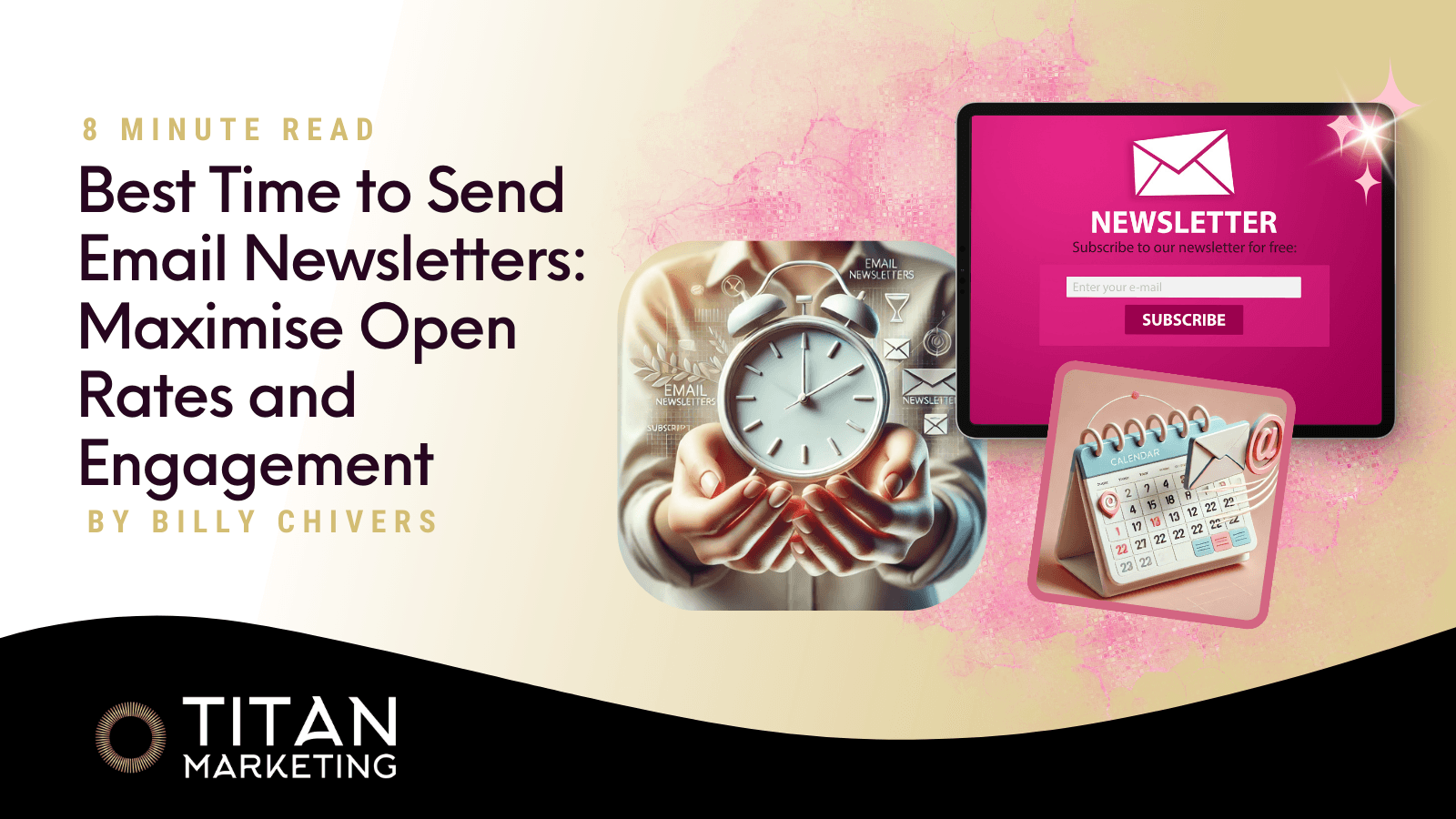
Blog
November 20, 2024

Blog
November 20, 2024

Blog
November 20, 2024
Discover the best time to send email newsletters with data-backed strategies, industry-specific insights, and smart Klaviyo tools to boost your open and click-through rates.
Why Timing Matters in Email Marketing
The Importance of Timing in Email Engagement
Timing is everything when it comes to email newsletters and email marketing strategies. Sending your email at the best time to send email newsletters can be the difference between high engagement and low interaction. Research has shown that the optimal time to send email newsletters directly influences email open rates, click-through rates, and even conversions.
A poorly timed email risks being overlooked, buried under other messages, or deleted outright. Crafting the perfect email is essential, but it will only succeed if it lands in your recipient’s inbox at a time when they’re most likely to read it. This blog delves into strategies, data-driven insights, and examples to help you identify the best times to send email newsletters and boost engagement.
Top 3 Takeaways for Quick Wins
Mid-Morning Sends Work Best: Studies highlight that emails sent between 9:00 AM and 11:00 AM achieve the highest open rates. (HubSpot)
Tailor Send Times by Audience: Different audience segments—based on behaviour, time zone, or engagement level—respond better to emails sent at specific times. (Mailshake)
A/B Testing Is Crucial: Regularly test different send times to find what resonates best with your unique audience. (Omnisend)
Key Findings on the Best Time to Send Email Newsletters
Industry Research and Data on Optimal Email Send Times
Numerous studies have pinpointed the optimal email send times for newsletters. HubSpot’s analysis shows that Tuesdays and Thursdays between 9:00 AM and 11:00 AM generate the highest email open rates. Similarly, Campaign Monitor found that emails sent mid-morning midweek are 20% more likely to be opened than those sent at other times. (HubSpot)
Example: An online retail brand doubled their sales by focusing on morning sends during the holiday season.
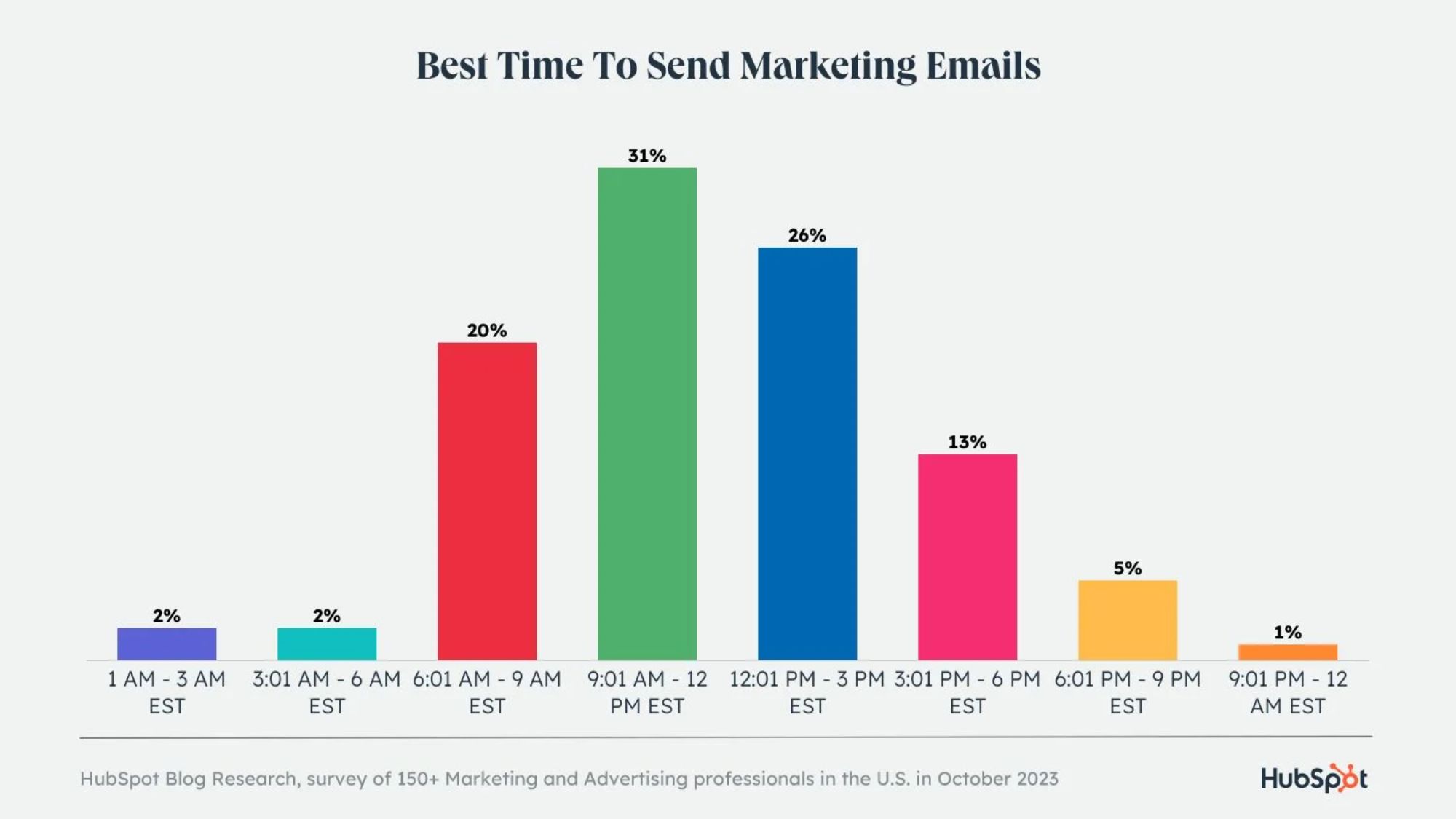
Source: HubSpot
Impact of Day and Time
Timing plays a crucial role in the success of email marketing campaigns. Analysing data from MailerLite's blog, we observe clear trends in engagement based on the day of the week and the specific time emails are sent.
Tuesdays and Thursdays are peak performers: Emails sent on these days tend to have the highest open rates across most industries. For instance:
Open rates peak at 41.41% on Tuesday at 11 AM.
Similarly, 42.49% on Thursday at 11 AM highlights a consistent preference for mid-morning sends.
Monday mornings show strong performance. With a 41.56% open rate at 11 AM, Monday mornings are ideal for kick-starting professional communications.
Weekend email performance varies: While open rates are generally lower, specific niches like entertainment or retail may benefit.

Understanding Timing by Industry
Optimal send times differ based on the industry:
Retail: Early mornings on weekdays perform best for promoting sales.
B2B: Professional audiences engage most with emails sent midweek between 8:00 AM and 10:00 AM.
SaaS: Thursday mornings or Monday afternoons work well for product announcements.
Data sourced from HubSpot and Omnisend
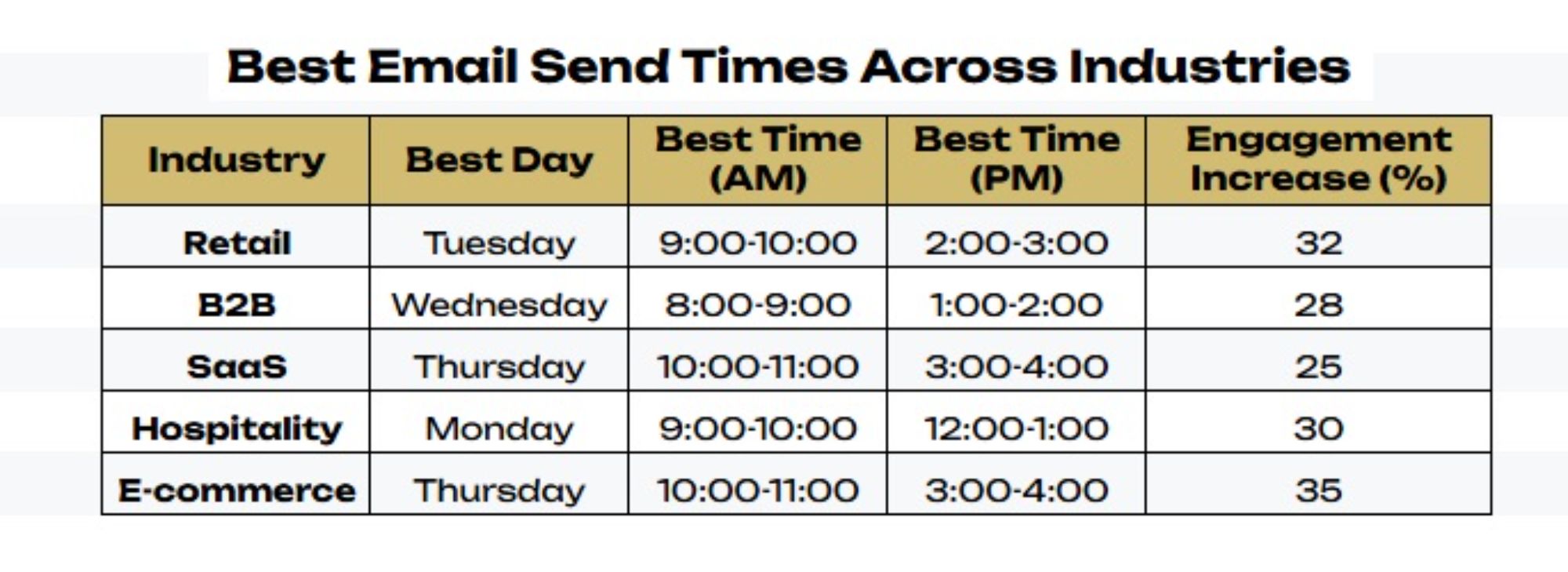
How to Find the Perfect Send Time for Your Audience
Using A/B Testing to Identify Optimal Times
A/B testing is a valuable tool in email marketing strategies. It allows marketers to experiment with different timing for email marketing to find the best fit for their audience. Split your audience into two or more groups and test varying send times for identical emails. Track key metrics to identify patterns in engagement.
Example 1: A subscription service tested emails sent at 8:00 AM, 12:00 PM, and 6:00 PM, discovering that evening emails led to higher conversions.
Example 2: A travel agency found that emails sent at 7:00 PM performed better than those sent in the afternoon.
Learn about essential A/B tests to boost email conversions and how to use timing as one of the key variables in your optimisation strategy.
Metrics to Monitor
When testing send times, monitor these key metrics:
Open Rate: Measures the percentage of recipients who open your email.
Click-Through Rate (CTR): Indicates the percentage of recipients who click links in your email.
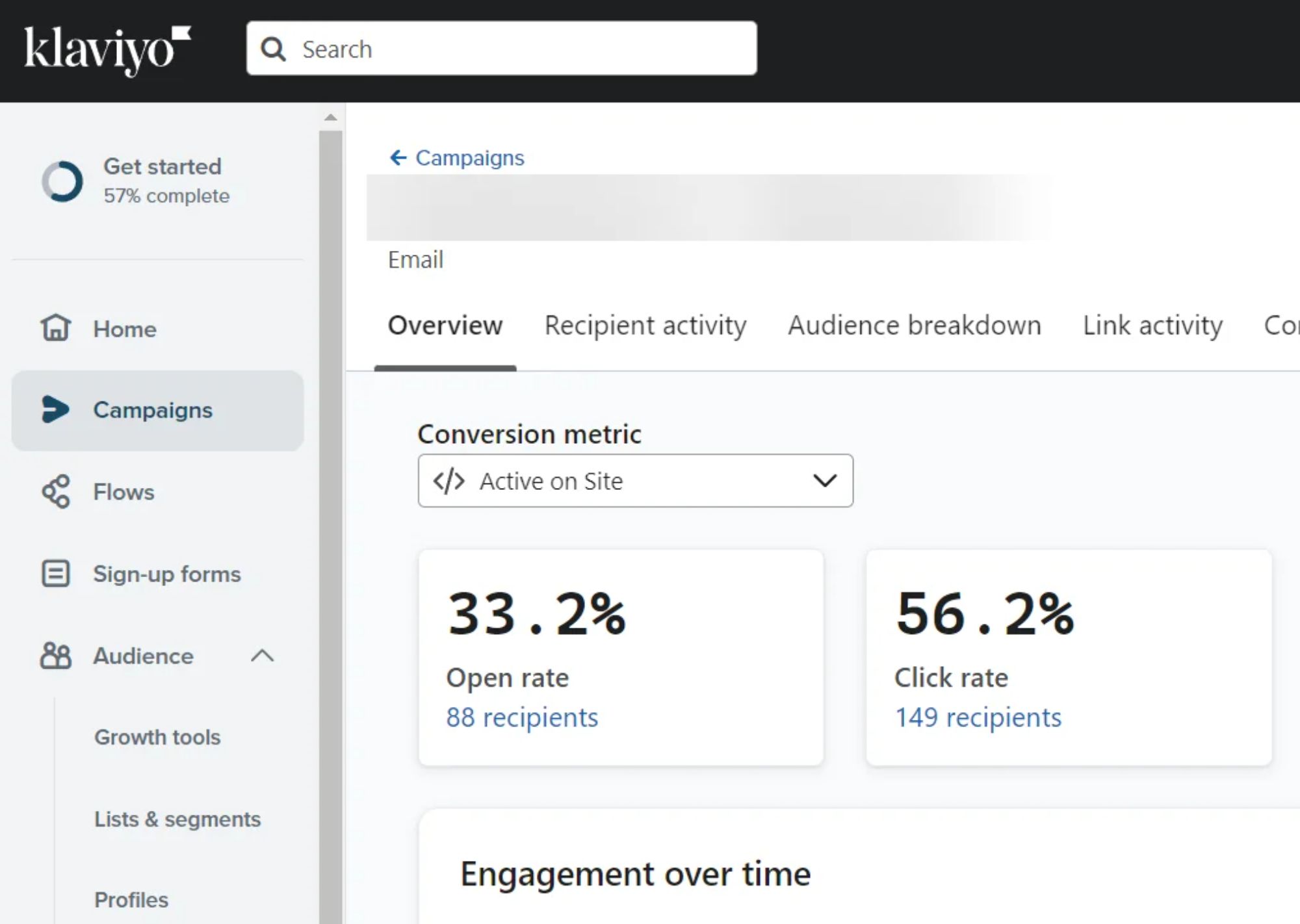
Source: Klaviyo
Klaviyo’s Smart Send AI Feature
Klaviyo’s Smart Send AI uses machine learning to recommend and automate the best time to send email newsletters. By analysing past engagement data, it predicts when recipients are most likely to open and interact with emails.
To explore how Klaviyo’s automation capabilities extend beyond just send times, read our Klaviyo Smart Sending guide for best practices on optimising frequency and engagement.
NOTE: Tools such as Klaviyo automatically send messages according to the recipient's time zone.
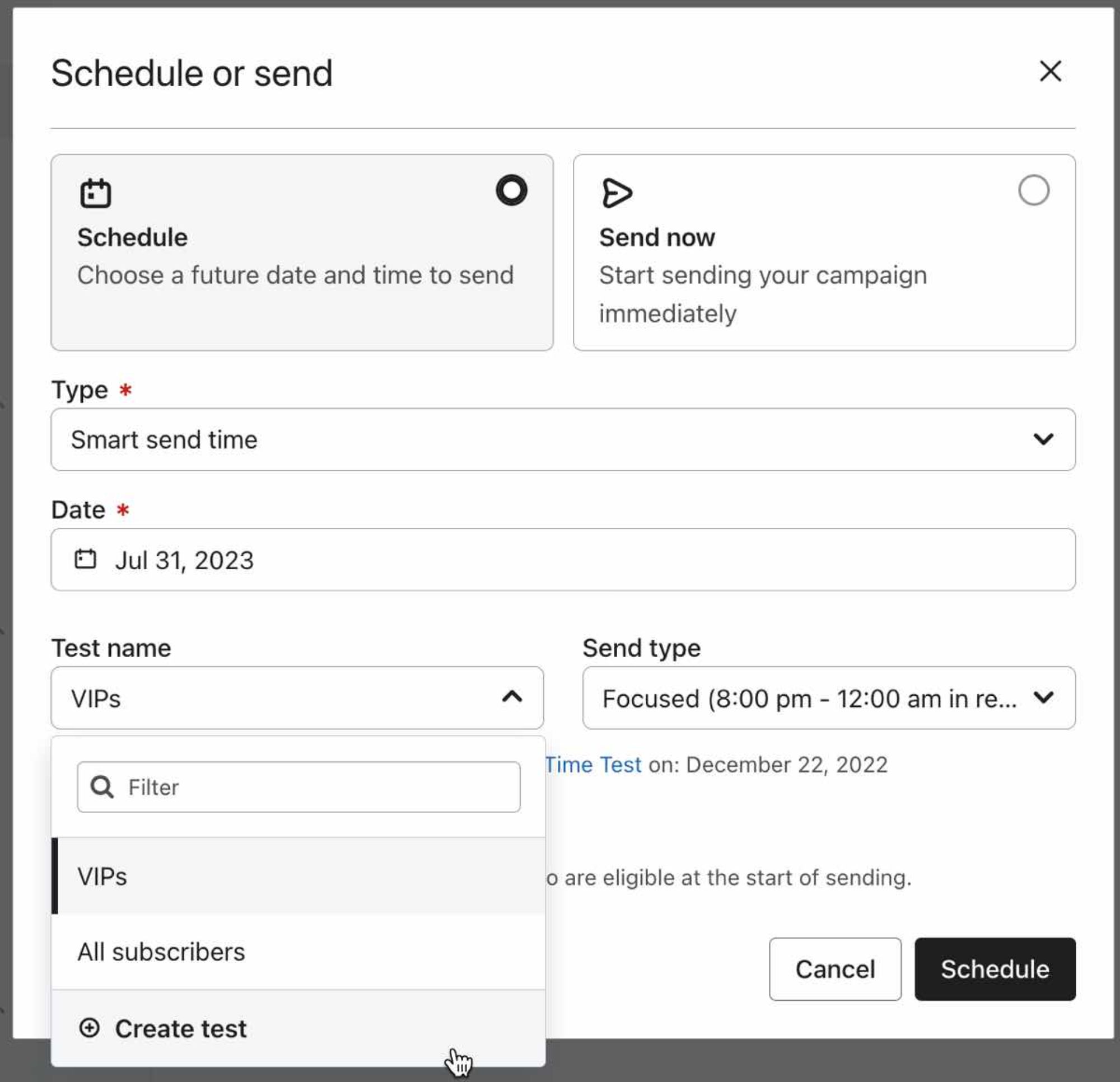

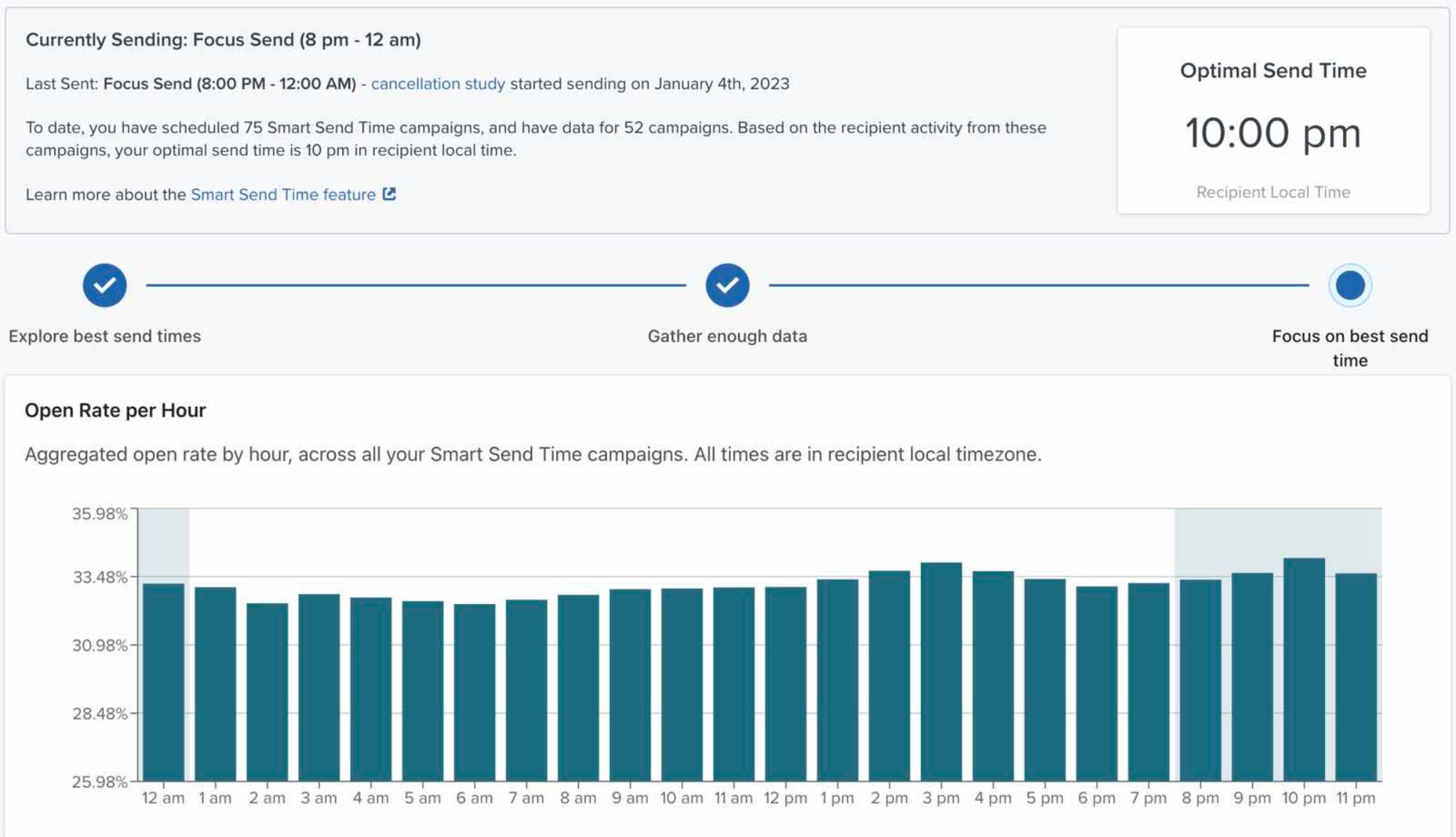
Source: Klaviyo
Tailoring Send Times by Audience: Optimising Send Times
Segmenting your audience ensures that emails are sent at times that align with their preferences and behaviours. Use demographic, geographic, and behavioural data to create personalised campaigns.
For more on how to segment by customer behaviour and preferences, check out our guide on 3 Klaviyo Segmentation Strategies to Boost DTC Sales.
Example 1: An international e-commerce brand scheduled emails for 10:00 AM local time in each recipient’s region, boosting engagement.
Example 2: A parenting blog targeted evening emails for busy parents, leading to an increase in clicks.
Additional Considerations for Testing Email Send Times
1. Mid-Morning Sends
Mid-morning (9:00 AM–11:00 AM) consistently shows higher engagement across most industries. This timeframe aligns with when many people check their emails during their workday or morning routines.
Pro Tips:
Test mid-morning times for different audience segments to identify the sweet spot.
Avoid Mondays, as inboxes are often crowded from the weekend.
2. Seasonality and Holidays
Email timing during holidays or shopping seasons should adapt to customer behaviours. Early-morning sends (7:00 AM–9:00 AM) often perform better as customers look for deals or reminders before starting their day.
Sending emails between 6 AM and 8 AM on Black Friday boosts open rates by 14%, as early shoppers are eager to catch the best deals. (Tabular)
A retail brand doubled holiday sales by scheduling pre-event emails 24 hours before major holidays.
Pro Tips:
Pair timing adjustments with seasonal promotions to increase urgency.
Test pre-event versus event-day sends to determine optimal engagement.
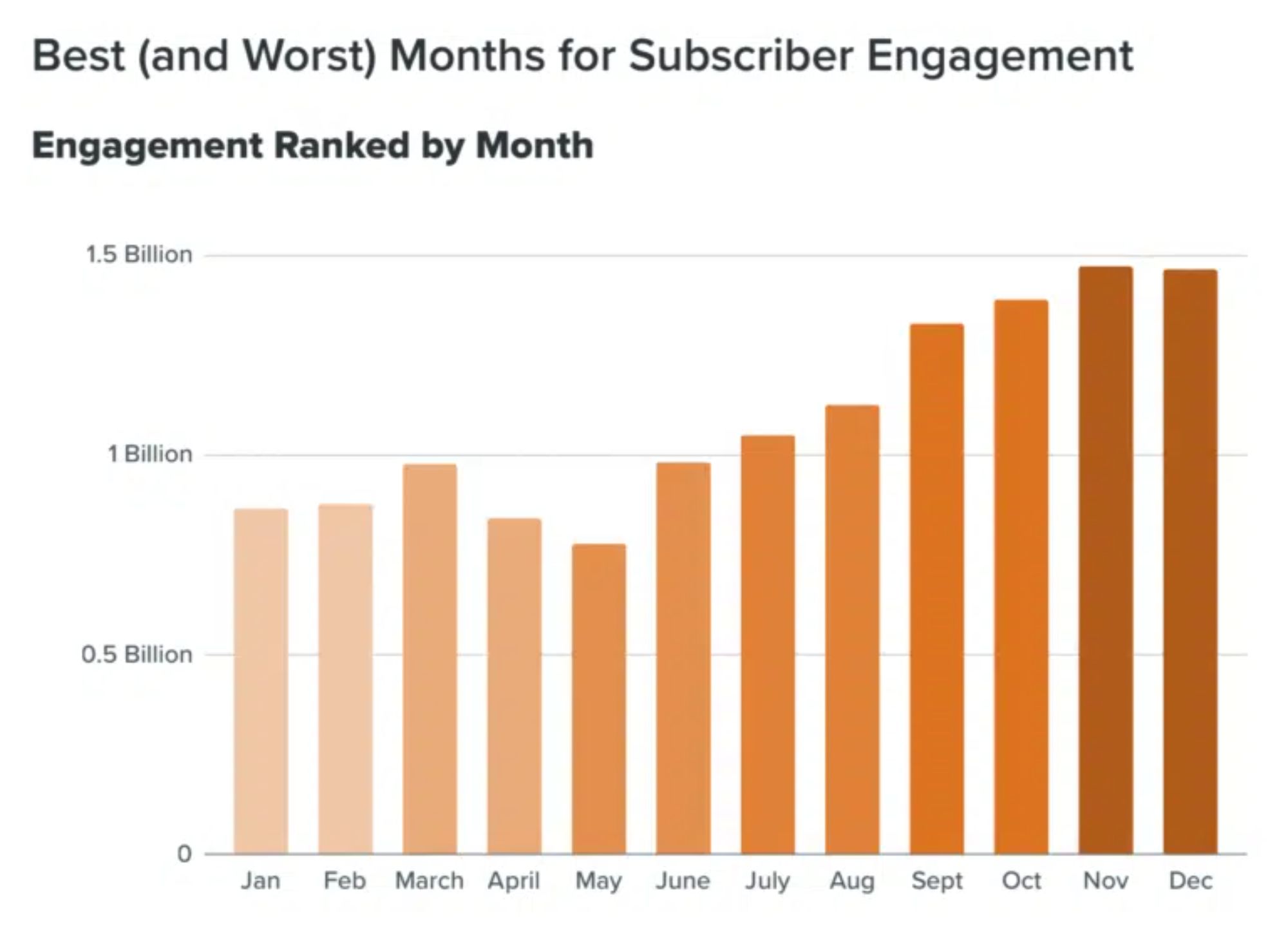
Source: Litmus
3. Weekend vs. Weekday Sends
Weekdays often outperform weekends for professional audiences, while retail and entertainment brands may find success on Saturdays or Sundays. The right timing depends heavily on your industry and audience habits.
Pro Tips:
Test weekend sends for B2C audiences and weekday sends for B2B.
Analyse historical performance to determine your audience’s preferences.
4. Afternoon and Evening Sends
For some audience segments, afternoon (1:00 PM–3:00 PM) and evening (6:00 PM–8:00 PM) emails can yield strong engagement. These times cater to after-lunch breaks and post-work hours.
Pro Tips:
Target professionals during post-lunch hours when they may be more likely to browse emails.
Use evening sends for casual, lifestyle, or entertainment content.
5. Time Zone Optimisation
Scheduling emails based on the recipient’s local time zone ensures that your message arrives during their peak engagement hours, regardless of geographic location.
Pro Tips:
Use tools like Klaviyo to automate time zone-specific sends.
For global campaigns, stagger sends to avoid overlaps and ensure even coverage.
Compare time zone optimisation features in Klaviyo vs. Mailchimp to see which platform suits your global campaign needs.

Source: Klaviyo
6. Urgency and Time-Sensitive Campaigns
For real-time offers, flash sales, or limited-time promotions, send emails during high-engagement windows, such as lunchtime (11:00 AM–12:30 PM) or just before the offer ends.
Adding countdown timers in email is one of the most effective ways to drive urgency during limited-time offers.
Pro Tips:
Pair urgent campaigns with clear CTAs and visually prominent countdown timers.
Test follow-up emails closer to the end of the promotion for last-minute conversions.
7. Frequency of Emails During Testing
During A/B testing for email timing, maintaining the right cadence is critical. Over-sending can lead to email fatigue, while under-sending might not provide enough data to draw meaningful conclusions.
For more tips on staying out of spam folders while testing frequency, read our email deliverability checklist.
Active segments responded best to 2–3 emails per week during testing.
Less engaged segments showed improved performance with once-weekly testing.
Pro Tips:
Monitor unsubscribe rates closely to ensure you’re not overwhelming your audience.
Use smaller audience subsets for initial tests to minimise risk.
Titan Case Study: Send time tests led to 20.42% higher opens for Blox Boom
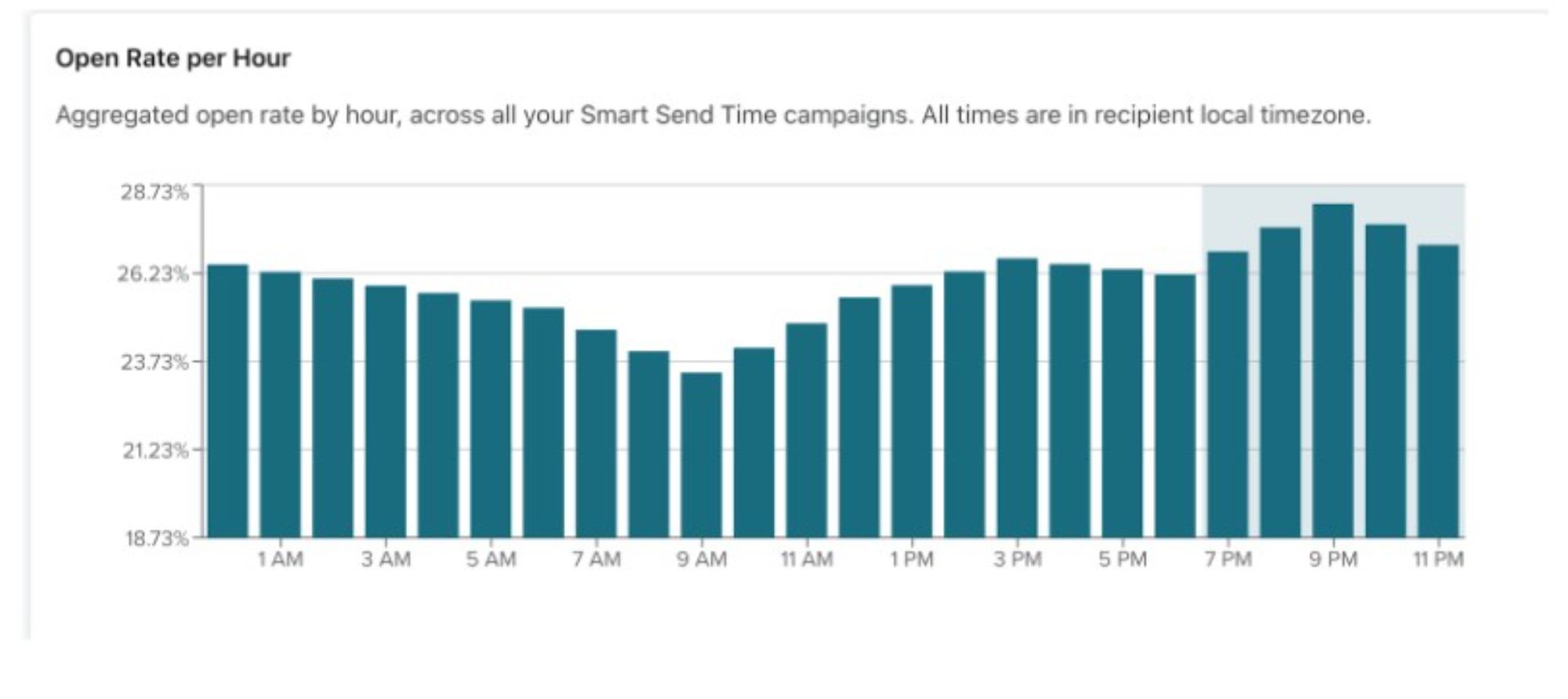
Blox Boom, a digital store for Roblox items, boosted open rates by 20.42% simply by sending campaigns at the optimal time.
Using Klaviyo’s Smart Send AI, Titan identified 9 PM as the sweet spot for their unique audience, scheduling weekly campaigns that hit inboxes when engagement was highest.
The result? More opens, better engagement, and a data-driven approach that maximised ROI.
Frequently Asked Questions (FAQ)
1. How can I ensure emails don’t get buried during high-traffic times?
To avoid competing with the flood of emails during peak times, schedule your newsletters strategically within your email marketing strategies. For example, early-morning sends (6:00–8:00 AM) often perform well before inboxes become cluttered. Additionally, mid-afternoon slots (1:00–3:00 PM) can work for audiences who catch up on emails after lunch.
Pro Tip: Avoid sending during universally busy times, such as Mondays at 9:00 AM, when most professionals are sorting through weekend emails. Tools like Klaviyo’s Smart Send AI can help identify less congested time slots.
2. What’s the best timing strategy for global campaigns with diverse audiences?
For global audiences, timing your emails to align with each recipient’s local time zone ensures they are received at optimal times. Use time zone-based segmentation and automation tools to deliver regionally targeted campaigns.
3. How do I tailor send times for B2B vs. B2C audiences?
B2B and B2C audiences have distinct habits. B2B recipients are most active during work hours, especially mid-morning on weekdays. In contrast, B2C audiences often engage more during leisure hours, such as evenings or weekends.
Pro Tip: Segment your audience by behaviour to tailor the timing for each group.
4. What’s the ideal timing for flash sales or urgent campaigns?
For time-sensitive promotions like flash sales, the best timing depends on your audience’s behavior. Sending real-time offers during peak activity hours (e.g., lunch breaks or post-work evenings) ensures visibility. Follow-up emails closer to the offer’s expiration can create urgency.
Pro Tip: Use countdown timers in emails to amplify urgency.
5. How often should I reevaluate my email timing strategy?
Reevaluating your timing strategy quarterly allows you to adapt to changing audience habits. Seasonal shifts, industry trends, or shifts in behaviour (e.g., post-pandemic changes in work schedules) can influence engagement.
Pro Tip: Regularly test and monitor engagement metrics like open rates and click-through rates to refine your strategy.
Conclusion
Timing is everything when it comes to email newsletters. Finding the best time to send email newsletters isn’t just about following general rules—it’s about understanding your audience and what works for them.
Whether it’s mid-morning sends, personalised timing based on behaviour, or leveraging tools like Klaviyo’s Smart Send AI, every tweak can make a difference. With a little testing and a lot of attention to your audience’s needs, you’ll turn well-timed emails into higher engagement, better relationships, and stronger results.
Key Takeaways
Mid-Morning Advantage: Sending emails between 9:00 AM and 11:00 AM on Tuesdays and Thursdays generally yields the highest engagement.
Personalise Timing by Audience: Use segmentation to schedule emails based on audience behaviours, time zones, and preferences.
Test and Adapt: Regular A/B testing reveals the best times for your unique audience, driving improved results.
Use Technology: Tools like Klaviyo’s Smart Send AI automate email delivery for time zone-specific optimisation.
Account for Seasonality: Adjust your timing during holidays or promotional periods for maximum impact.
Prioritise Metrics: Continuously monitor open rates and click-through rates to refine your strategy.
Are You Sending Your Newsletters at the Right Time?
Discover how finding the best time to send email newsletters can transform your engagement rates. Click here to learn more and get a FREE audit to optimise your email strategy and connect with your audience like never before!
Why Timing Matters in Email Marketing
The Importance of Timing in Email Engagement
Timing is everything when it comes to email newsletters and email marketing strategies. Sending your email at the best time to send email newsletters can be the difference between high engagement and low interaction. Research has shown that the optimal time to send email newsletters directly influences email open rates, click-through rates, and even conversions.
A poorly timed email risks being overlooked, buried under other messages, or deleted outright. Crafting the perfect email is essential, but it will only succeed if it lands in your recipient’s inbox at a time when they’re most likely to read it. This blog delves into strategies, data-driven insights, and examples to help you identify the best times to send email newsletters and boost engagement.
Top 3 Takeaways for Quick Wins
Mid-Morning Sends Work Best: Studies highlight that emails sent between 9:00 AM and 11:00 AM achieve the highest open rates. (HubSpot)
Tailor Send Times by Audience: Different audience segments—based on behaviour, time zone, or engagement level—respond better to emails sent at specific times. (Mailshake)
A/B Testing Is Crucial: Regularly test different send times to find what resonates best with your unique audience. (Omnisend)
Key Findings on the Best Time to Send Email Newsletters
Industry Research and Data on Optimal Email Send Times
Numerous studies have pinpointed the optimal email send times for newsletters. HubSpot’s analysis shows that Tuesdays and Thursdays between 9:00 AM and 11:00 AM generate the highest email open rates. Similarly, Campaign Monitor found that emails sent mid-morning midweek are 20% more likely to be opened than those sent at other times. (HubSpot)
Example: An online retail brand doubled their sales by focusing on morning sends during the holiday season.

Source: HubSpot
Impact of Day and Time
Timing plays a crucial role in the success of email marketing campaigns. Analysing data from MailerLite's blog, we observe clear trends in engagement based on the day of the week and the specific time emails are sent.
Tuesdays and Thursdays are peak performers: Emails sent on these days tend to have the highest open rates across most industries. For instance:
Open rates peak at 41.41% on Tuesday at 11 AM.
Similarly, 42.49% on Thursday at 11 AM highlights a consistent preference for mid-morning sends.
Monday mornings show strong performance. With a 41.56% open rate at 11 AM, Monday mornings are ideal for kick-starting professional communications.
Weekend email performance varies: While open rates are generally lower, specific niches like entertainment or retail may benefit.

Understanding Timing by Industry
Optimal send times differ based on the industry:
Retail: Early mornings on weekdays perform best for promoting sales.
B2B: Professional audiences engage most with emails sent midweek between 8:00 AM and 10:00 AM.
SaaS: Thursday mornings or Monday afternoons work well for product announcements.
Data sourced from HubSpot and Omnisend

How to Find the Perfect Send Time for Your Audience
Using A/B Testing to Identify Optimal Times
A/B testing is a valuable tool in email marketing strategies. It allows marketers to experiment with different timing for email marketing to find the best fit for their audience. Split your audience into two or more groups and test varying send times for identical emails. Track key metrics to identify patterns in engagement.
Example 1: A subscription service tested emails sent at 8:00 AM, 12:00 PM, and 6:00 PM, discovering that evening emails led to higher conversions.
Example 2: A travel agency found that emails sent at 7:00 PM performed better than those sent in the afternoon.
Learn about essential A/B tests to boost email conversions and how to use timing as one of the key variables in your optimisation strategy.
Metrics to Monitor
When testing send times, monitor these key metrics:
Open Rate: Measures the percentage of recipients who open your email.
Click-Through Rate (CTR): Indicates the percentage of recipients who click links in your email.

Source: Klaviyo
Klaviyo’s Smart Send AI Feature
Klaviyo’s Smart Send AI uses machine learning to recommend and automate the best time to send email newsletters. By analysing past engagement data, it predicts when recipients are most likely to open and interact with emails.
To explore how Klaviyo’s automation capabilities extend beyond just send times, read our Klaviyo Smart Sending guide for best practices on optimising frequency and engagement.
NOTE: Tools such as Klaviyo automatically send messages according to the recipient's time zone.



Source: Klaviyo
Tailoring Send Times by Audience: Optimising Send Times
Segmenting your audience ensures that emails are sent at times that align with their preferences and behaviours. Use demographic, geographic, and behavioural data to create personalised campaigns.
For more on how to segment by customer behaviour and preferences, check out our guide on 3 Klaviyo Segmentation Strategies to Boost DTC Sales.
Example 1: An international e-commerce brand scheduled emails for 10:00 AM local time in each recipient’s region, boosting engagement.
Example 2: A parenting blog targeted evening emails for busy parents, leading to an increase in clicks.
Additional Considerations for Testing Email Send Times
1. Mid-Morning Sends
Mid-morning (9:00 AM–11:00 AM) consistently shows higher engagement across most industries. This timeframe aligns with when many people check their emails during their workday or morning routines.
Pro Tips:
Test mid-morning times for different audience segments to identify the sweet spot.
Avoid Mondays, as inboxes are often crowded from the weekend.
2. Seasonality and Holidays
Email timing during holidays or shopping seasons should adapt to customer behaviours. Early-morning sends (7:00 AM–9:00 AM) often perform better as customers look for deals or reminders before starting their day.
Sending emails between 6 AM and 8 AM on Black Friday boosts open rates by 14%, as early shoppers are eager to catch the best deals. (Tabular)
A retail brand doubled holiday sales by scheduling pre-event emails 24 hours before major holidays.
Pro Tips:
Pair timing adjustments with seasonal promotions to increase urgency.
Test pre-event versus event-day sends to determine optimal engagement.

Source: Litmus
3. Weekend vs. Weekday Sends
Weekdays often outperform weekends for professional audiences, while retail and entertainment brands may find success on Saturdays or Sundays. The right timing depends heavily on your industry and audience habits.
Pro Tips:
Test weekend sends for B2C audiences and weekday sends for B2B.
Analyse historical performance to determine your audience’s preferences.
4. Afternoon and Evening Sends
For some audience segments, afternoon (1:00 PM–3:00 PM) and evening (6:00 PM–8:00 PM) emails can yield strong engagement. These times cater to after-lunch breaks and post-work hours.
Pro Tips:
Target professionals during post-lunch hours when they may be more likely to browse emails.
Use evening sends for casual, lifestyle, or entertainment content.
5. Time Zone Optimisation
Scheduling emails based on the recipient’s local time zone ensures that your message arrives during their peak engagement hours, regardless of geographic location.
Pro Tips:
Use tools like Klaviyo to automate time zone-specific sends.
For global campaigns, stagger sends to avoid overlaps and ensure even coverage.
Compare time zone optimisation features in Klaviyo vs. Mailchimp to see which platform suits your global campaign needs.

Source: Klaviyo
6. Urgency and Time-Sensitive Campaigns
For real-time offers, flash sales, or limited-time promotions, send emails during high-engagement windows, such as lunchtime (11:00 AM–12:30 PM) or just before the offer ends.
Adding countdown timers in email is one of the most effective ways to drive urgency during limited-time offers.
Pro Tips:
Pair urgent campaigns with clear CTAs and visually prominent countdown timers.
Test follow-up emails closer to the end of the promotion for last-minute conversions.
7. Frequency of Emails During Testing
During A/B testing for email timing, maintaining the right cadence is critical. Over-sending can lead to email fatigue, while under-sending might not provide enough data to draw meaningful conclusions.
For more tips on staying out of spam folders while testing frequency, read our email deliverability checklist.
Active segments responded best to 2–3 emails per week during testing.
Less engaged segments showed improved performance with once-weekly testing.
Pro Tips:
Monitor unsubscribe rates closely to ensure you’re not overwhelming your audience.
Use smaller audience subsets for initial tests to minimise risk.
Titan Case Study: Send time tests led to 20.42% higher opens for Blox Boom

Blox Boom, a digital store for Roblox items, boosted open rates by 20.42% simply by sending campaigns at the optimal time.
Using Klaviyo’s Smart Send AI, Titan identified 9 PM as the sweet spot for their unique audience, scheduling weekly campaigns that hit inboxes when engagement was highest.
The result? More opens, better engagement, and a data-driven approach that maximised ROI.
Frequently Asked Questions (FAQ)
1. How can I ensure emails don’t get buried during high-traffic times?
To avoid competing with the flood of emails during peak times, schedule your newsletters strategically within your email marketing strategies. For example, early-morning sends (6:00–8:00 AM) often perform well before inboxes become cluttered. Additionally, mid-afternoon slots (1:00–3:00 PM) can work for audiences who catch up on emails after lunch.
Pro Tip: Avoid sending during universally busy times, such as Mondays at 9:00 AM, when most professionals are sorting through weekend emails. Tools like Klaviyo’s Smart Send AI can help identify less congested time slots.
2. What’s the best timing strategy for global campaigns with diverse audiences?
For global audiences, timing your emails to align with each recipient’s local time zone ensures they are received at optimal times. Use time zone-based segmentation and automation tools to deliver regionally targeted campaigns.
3. How do I tailor send times for B2B vs. B2C audiences?
B2B and B2C audiences have distinct habits. B2B recipients are most active during work hours, especially mid-morning on weekdays. In contrast, B2C audiences often engage more during leisure hours, such as evenings or weekends.
Pro Tip: Segment your audience by behaviour to tailor the timing for each group.
4. What’s the ideal timing for flash sales or urgent campaigns?
For time-sensitive promotions like flash sales, the best timing depends on your audience’s behavior. Sending real-time offers during peak activity hours (e.g., lunch breaks or post-work evenings) ensures visibility. Follow-up emails closer to the offer’s expiration can create urgency.
Pro Tip: Use countdown timers in emails to amplify urgency.
5. How often should I reevaluate my email timing strategy?
Reevaluating your timing strategy quarterly allows you to adapt to changing audience habits. Seasonal shifts, industry trends, or shifts in behaviour (e.g., post-pandemic changes in work schedules) can influence engagement.
Pro Tip: Regularly test and monitor engagement metrics like open rates and click-through rates to refine your strategy.
Conclusion
Timing is everything when it comes to email newsletters. Finding the best time to send email newsletters isn’t just about following general rules—it’s about understanding your audience and what works for them.
Whether it’s mid-morning sends, personalised timing based on behaviour, or leveraging tools like Klaviyo’s Smart Send AI, every tweak can make a difference. With a little testing and a lot of attention to your audience’s needs, you’ll turn well-timed emails into higher engagement, better relationships, and stronger results.
Key Takeaways
Mid-Morning Advantage: Sending emails between 9:00 AM and 11:00 AM on Tuesdays and Thursdays generally yields the highest engagement.
Personalise Timing by Audience: Use segmentation to schedule emails based on audience behaviours, time zones, and preferences.
Test and Adapt: Regular A/B testing reveals the best times for your unique audience, driving improved results.
Use Technology: Tools like Klaviyo’s Smart Send AI automate email delivery for time zone-specific optimisation.
Account for Seasonality: Adjust your timing during holidays or promotional periods for maximum impact.
Prioritise Metrics: Continuously monitor open rates and click-through rates to refine your strategy.
Are You Sending Your Newsletters at the Right Time?
Discover how finding the best time to send email newsletters can transform your engagement rates. Click here to learn more and get a FREE audit to optimise your email strategy and connect with your audience like never before!
Discover the best time to send email newsletters with data-backed strategies, industry-specific insights, and smart Klaviyo tools to boost your open and click-through rates.
Why Timing Matters in Email Marketing
The Importance of Timing in Email Engagement
Timing is everything when it comes to email newsletters and email marketing strategies. Sending your email at the best time to send email newsletters can be the difference between high engagement and low interaction. Research has shown that the optimal time to send email newsletters directly influences email open rates, click-through rates, and even conversions.
A poorly timed email risks being overlooked, buried under other messages, or deleted outright. Crafting the perfect email is essential, but it will only succeed if it lands in your recipient’s inbox at a time when they’re most likely to read it. This blog delves into strategies, data-driven insights, and examples to help you identify the best times to send email newsletters and boost engagement.
Top 3 Takeaways for Quick Wins
Mid-Morning Sends Work Best: Studies highlight that emails sent between 9:00 AM and 11:00 AM achieve the highest open rates. (HubSpot)
Tailor Send Times by Audience: Different audience segments—based on behaviour, time zone, or engagement level—respond better to emails sent at specific times. (Mailshake)
A/B Testing Is Crucial: Regularly test different send times to find what resonates best with your unique audience. (Omnisend)
Key Findings on the Best Time to Send Email Newsletters
Industry Research and Data on Optimal Email Send Times
Numerous studies have pinpointed the optimal email send times for newsletters. HubSpot’s analysis shows that Tuesdays and Thursdays between 9:00 AM and 11:00 AM generate the highest email open rates. Similarly, Campaign Monitor found that emails sent mid-morning midweek are 20% more likely to be opened than those sent at other times. (HubSpot)
Example: An online retail brand doubled their sales by focusing on morning sends during the holiday season.

Source: HubSpot
Impact of Day and Time
Timing plays a crucial role in the success of email marketing campaigns. Analysing data from MailerLite's blog, we observe clear trends in engagement based on the day of the week and the specific time emails are sent.
Tuesdays and Thursdays are peak performers: Emails sent on these days tend to have the highest open rates across most industries. For instance:
Open rates peak at 41.41% on Tuesday at 11 AM.
Similarly, 42.49% on Thursday at 11 AM highlights a consistent preference for mid-morning sends.
Monday mornings show strong performance. With a 41.56% open rate at 11 AM, Monday mornings are ideal for kick-starting professional communications.
Weekend email performance varies: While open rates are generally lower, specific niches like entertainment or retail may benefit.

Understanding Timing by Industry
Optimal send times differ based on the industry:
Retail: Early mornings on weekdays perform best for promoting sales.
B2B: Professional audiences engage most with emails sent midweek between 8:00 AM and 10:00 AM.
SaaS: Thursday mornings or Monday afternoons work well for product announcements.
Data sourced from HubSpot and Omnisend

How to Find the Perfect Send Time for Your Audience
Using A/B Testing to Identify Optimal Times
A/B testing is a valuable tool in email marketing strategies. It allows marketers to experiment with different timing for email marketing to find the best fit for their audience. Split your audience into two or more groups and test varying send times for identical emails. Track key metrics to identify patterns in engagement.
Example 1: A subscription service tested emails sent at 8:00 AM, 12:00 PM, and 6:00 PM, discovering that evening emails led to higher conversions.
Example 2: A travel agency found that emails sent at 7:00 PM performed better than those sent in the afternoon.
Learn about essential A/B tests to boost email conversions and how to use timing as one of the key variables in your optimisation strategy.
Metrics to Monitor
When testing send times, monitor these key metrics:
Open Rate: Measures the percentage of recipients who open your email.
Click-Through Rate (CTR): Indicates the percentage of recipients who click links in your email.

Source: Klaviyo
Klaviyo’s Smart Send AI Feature
Klaviyo’s Smart Send AI uses machine learning to recommend and automate the best time to send email newsletters. By analysing past engagement data, it predicts when recipients are most likely to open and interact with emails.
To explore how Klaviyo’s automation capabilities extend beyond just send times, read our Klaviyo Smart Sending guide for best practices on optimising frequency and engagement.
NOTE: Tools such as Klaviyo automatically send messages according to the recipient's time zone.



Source: Klaviyo
Tailoring Send Times by Audience: Optimising Send Times
Segmenting your audience ensures that emails are sent at times that align with their preferences and behaviours. Use demographic, geographic, and behavioural data to create personalised campaigns.
For more on how to segment by customer behaviour and preferences, check out our guide on 3 Klaviyo Segmentation Strategies to Boost DTC Sales.
Example 1: An international e-commerce brand scheduled emails for 10:00 AM local time in each recipient’s region, boosting engagement.
Example 2: A parenting blog targeted evening emails for busy parents, leading to an increase in clicks.
Additional Considerations for Testing Email Send Times
1. Mid-Morning Sends
Mid-morning (9:00 AM–11:00 AM) consistently shows higher engagement across most industries. This timeframe aligns with when many people check their emails during their workday or morning routines.
Pro Tips:
Test mid-morning times for different audience segments to identify the sweet spot.
Avoid Mondays, as inboxes are often crowded from the weekend.
2. Seasonality and Holidays
Email timing during holidays or shopping seasons should adapt to customer behaviours. Early-morning sends (7:00 AM–9:00 AM) often perform better as customers look for deals or reminders before starting their day.
Sending emails between 6 AM and 8 AM on Black Friday boosts open rates by 14%, as early shoppers are eager to catch the best deals. (Tabular)
A retail brand doubled holiday sales by scheduling pre-event emails 24 hours before major holidays.
Pro Tips:
Pair timing adjustments with seasonal promotions to increase urgency.
Test pre-event versus event-day sends to determine optimal engagement.

Source: Litmus
3. Weekend vs. Weekday Sends
Weekdays often outperform weekends for professional audiences, while retail and entertainment brands may find success on Saturdays or Sundays. The right timing depends heavily on your industry and audience habits.
Pro Tips:
Test weekend sends for B2C audiences and weekday sends for B2B.
Analyse historical performance to determine your audience’s preferences.
4. Afternoon and Evening Sends
For some audience segments, afternoon (1:00 PM–3:00 PM) and evening (6:00 PM–8:00 PM) emails can yield strong engagement. These times cater to after-lunch breaks and post-work hours.
Pro Tips:
Target professionals during post-lunch hours when they may be more likely to browse emails.
Use evening sends for casual, lifestyle, or entertainment content.
5. Time Zone Optimisation
Scheduling emails based on the recipient’s local time zone ensures that your message arrives during their peak engagement hours, regardless of geographic location.
Pro Tips:
Use tools like Klaviyo to automate time zone-specific sends.
For global campaigns, stagger sends to avoid overlaps and ensure even coverage.
Compare time zone optimisation features in Klaviyo vs. Mailchimp to see which platform suits your global campaign needs.

Source: Klaviyo
6. Urgency and Time-Sensitive Campaigns
For real-time offers, flash sales, or limited-time promotions, send emails during high-engagement windows, such as lunchtime (11:00 AM–12:30 PM) or just before the offer ends.
Adding countdown timers in email is one of the most effective ways to drive urgency during limited-time offers.
Pro Tips:
Pair urgent campaigns with clear CTAs and visually prominent countdown timers.
Test follow-up emails closer to the end of the promotion for last-minute conversions.
7. Frequency of Emails During Testing
During A/B testing for email timing, maintaining the right cadence is critical. Over-sending can lead to email fatigue, while under-sending might not provide enough data to draw meaningful conclusions.
For more tips on staying out of spam folders while testing frequency, read our email deliverability checklist.
Active segments responded best to 2–3 emails per week during testing.
Less engaged segments showed improved performance with once-weekly testing.
Pro Tips:
Monitor unsubscribe rates closely to ensure you’re not overwhelming your audience.
Use smaller audience subsets for initial tests to minimise risk.
Titan Case Study: Send time tests led to 20.42% higher opens for Blox Boom

Blox Boom, a digital store for Roblox items, boosted open rates by 20.42% simply by sending campaigns at the optimal time.
Using Klaviyo’s Smart Send AI, Titan identified 9 PM as the sweet spot for their unique audience, scheduling weekly campaigns that hit inboxes when engagement was highest.
The result? More opens, better engagement, and a data-driven approach that maximised ROI.
Frequently Asked Questions (FAQ)
1. How can I ensure emails don’t get buried during high-traffic times?
To avoid competing with the flood of emails during peak times, schedule your newsletters strategically within your email marketing strategies. For example, early-morning sends (6:00–8:00 AM) often perform well before inboxes become cluttered. Additionally, mid-afternoon slots (1:00–3:00 PM) can work for audiences who catch up on emails after lunch.
Pro Tip: Avoid sending during universally busy times, such as Mondays at 9:00 AM, when most professionals are sorting through weekend emails. Tools like Klaviyo’s Smart Send AI can help identify less congested time slots.
2. What’s the best timing strategy for global campaigns with diverse audiences?
For global audiences, timing your emails to align with each recipient’s local time zone ensures they are received at optimal times. Use time zone-based segmentation and automation tools to deliver regionally targeted campaigns.
3. How do I tailor send times for B2B vs. B2C audiences?
B2B and B2C audiences have distinct habits. B2B recipients are most active during work hours, especially mid-morning on weekdays. In contrast, B2C audiences often engage more during leisure hours, such as evenings or weekends.
Pro Tip: Segment your audience by behaviour to tailor the timing for each group.
4. What’s the ideal timing for flash sales or urgent campaigns?
For time-sensitive promotions like flash sales, the best timing depends on your audience’s behavior. Sending real-time offers during peak activity hours (e.g., lunch breaks or post-work evenings) ensures visibility. Follow-up emails closer to the offer’s expiration can create urgency.
Pro Tip: Use countdown timers in emails to amplify urgency.
5. How often should I reevaluate my email timing strategy?
Reevaluating your timing strategy quarterly allows you to adapt to changing audience habits. Seasonal shifts, industry trends, or shifts in behaviour (e.g., post-pandemic changes in work schedules) can influence engagement.
Pro Tip: Regularly test and monitor engagement metrics like open rates and click-through rates to refine your strategy.
Conclusion
Timing is everything when it comes to email newsletters. Finding the best time to send email newsletters isn’t just about following general rules—it’s about understanding your audience and what works for them.
Whether it’s mid-morning sends, personalised timing based on behaviour, or leveraging tools like Klaviyo’s Smart Send AI, every tweak can make a difference. With a little testing and a lot of attention to your audience’s needs, you’ll turn well-timed emails into higher engagement, better relationships, and stronger results.
Key Takeaways
Mid-Morning Advantage: Sending emails between 9:00 AM and 11:00 AM on Tuesdays and Thursdays generally yields the highest engagement.
Personalise Timing by Audience: Use segmentation to schedule emails based on audience behaviours, time zones, and preferences.
Test and Adapt: Regular A/B testing reveals the best times for your unique audience, driving improved results.
Use Technology: Tools like Klaviyo’s Smart Send AI automate email delivery for time zone-specific optimisation.
Account for Seasonality: Adjust your timing during holidays or promotional periods for maximum impact.
Prioritise Metrics: Continuously monitor open rates and click-through rates to refine your strategy.
Are You Sending Your Newsletters at the Right Time?
Discover how finding the best time to send email newsletters can transform your engagement rates. Click here to learn more and get a FREE audit to optimise your email strategy and connect with your audience like never before!
Join our newsletter list
Sign up to get the most recent blog articles in your email every week.
Other Blogs
Other Blogs
Check our other project Blogs with useful insight and information for your businesses
Other Blogs
Other Blogs
Check our other project Blogs with useful insight and information for your businesses
Other Blogs
Other Blogs
Check our other project Blogs with useful insight and information for your businesses


